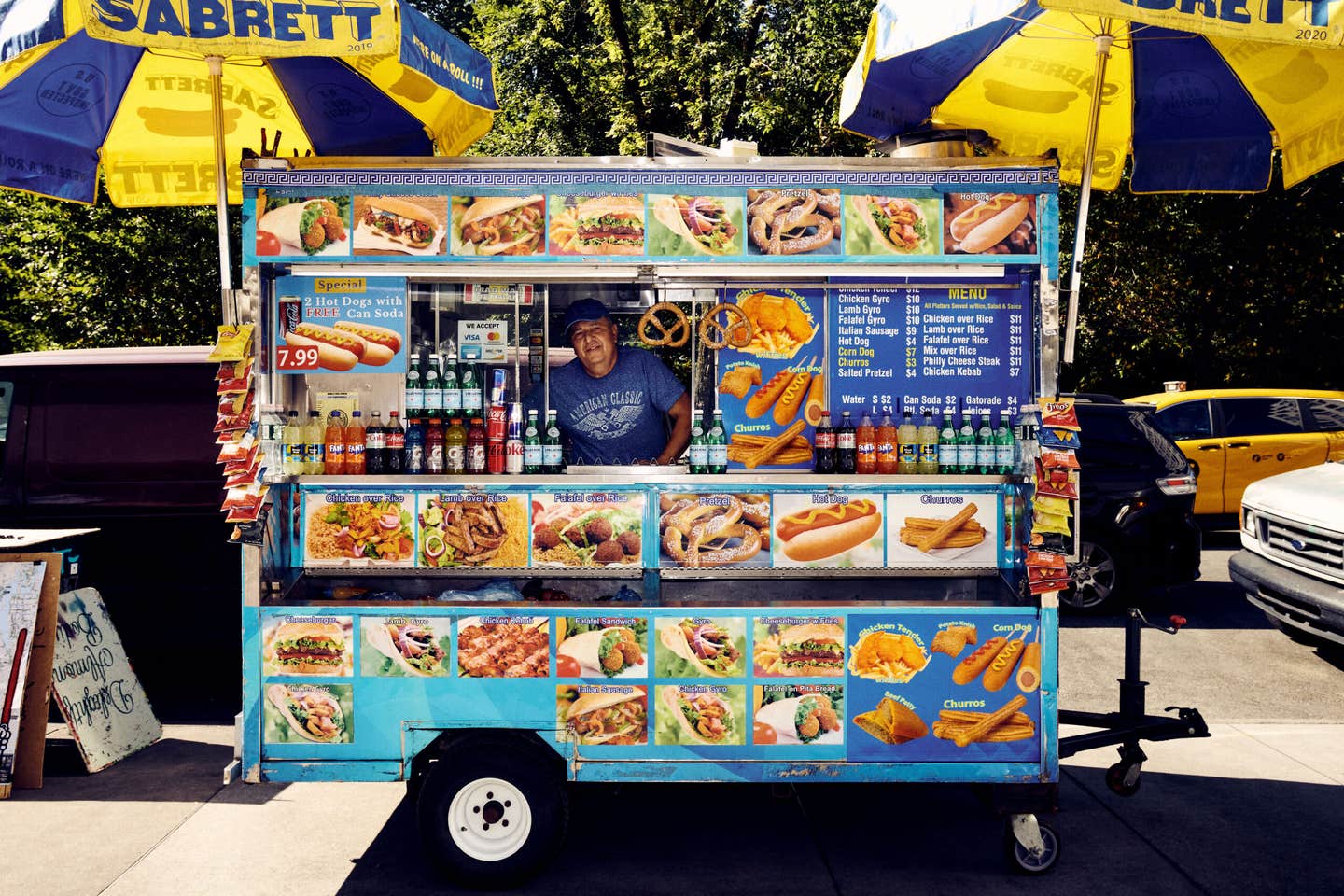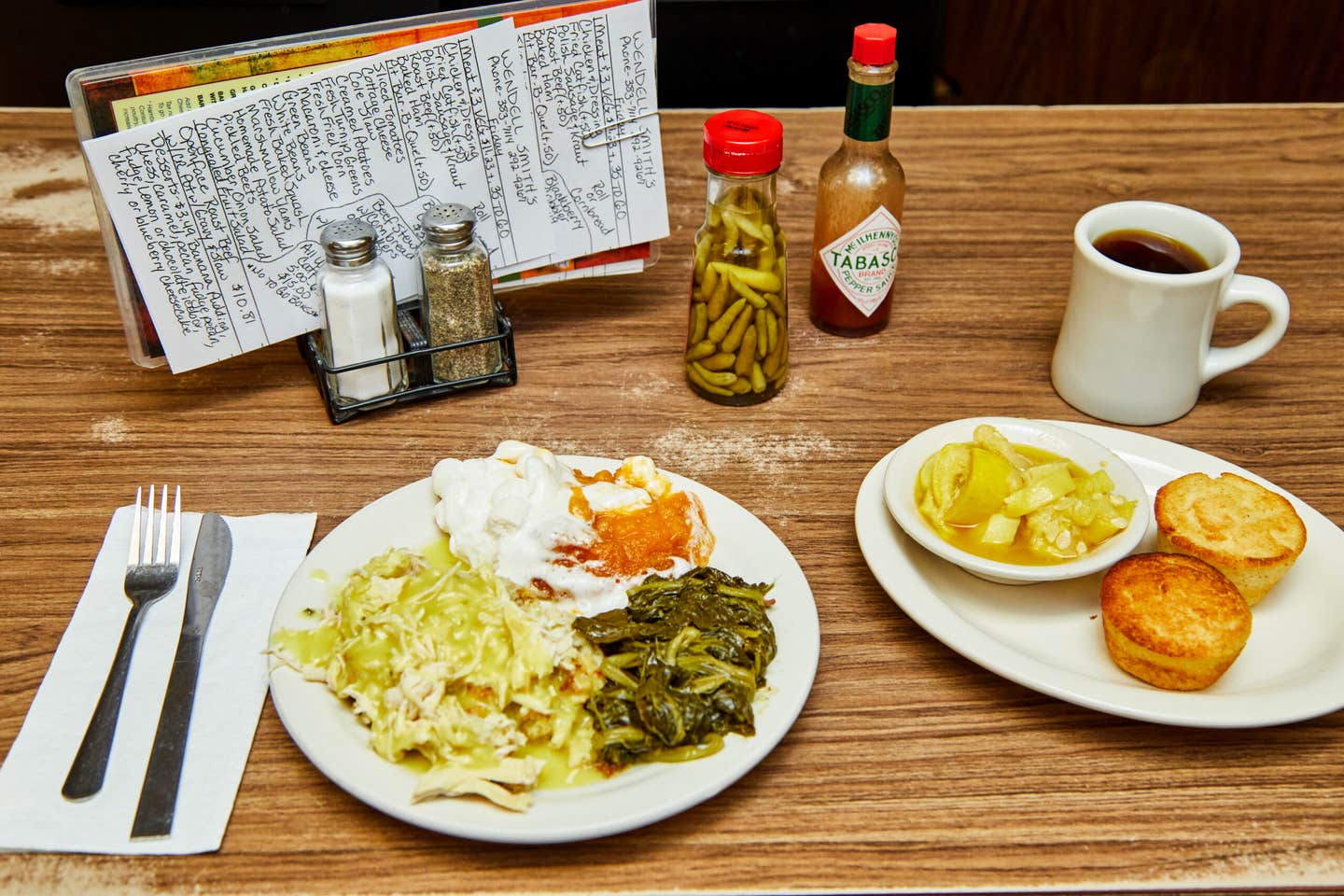
Despite Nashville’s Rapid Growth, The City’s Longtime Restaurants Hold on to Their Community Spirit
And still serve up the ultimate hot chicken sandwich.
It’s 9:30 a.m. on a Thursday, and Wendell Smith’s Restaurant is slammed.
At this historic West Nashville diner serving up classic Southern-style meat-and-threes (a main plus three sides), the coffee flows freely, the raucous conversations push the low ceiling to its limits, and in the middle of it all, owner Benji Cook shows no signs of slowing down.
“Golly, I’ve been here since 1992,” says Cook as he sits down at an empty table in between serving customers. He’s the third generation of his family to run Wendell Smith’s—his grandfather opened the restaurant in 1952—and the establishment has remained in the same spot these past 70 years. “They used to [serve] steak and spaghetti and burgers,” he recalls. But after Cook’s father introduced the meat-and-threes concept, the restaurant took off.
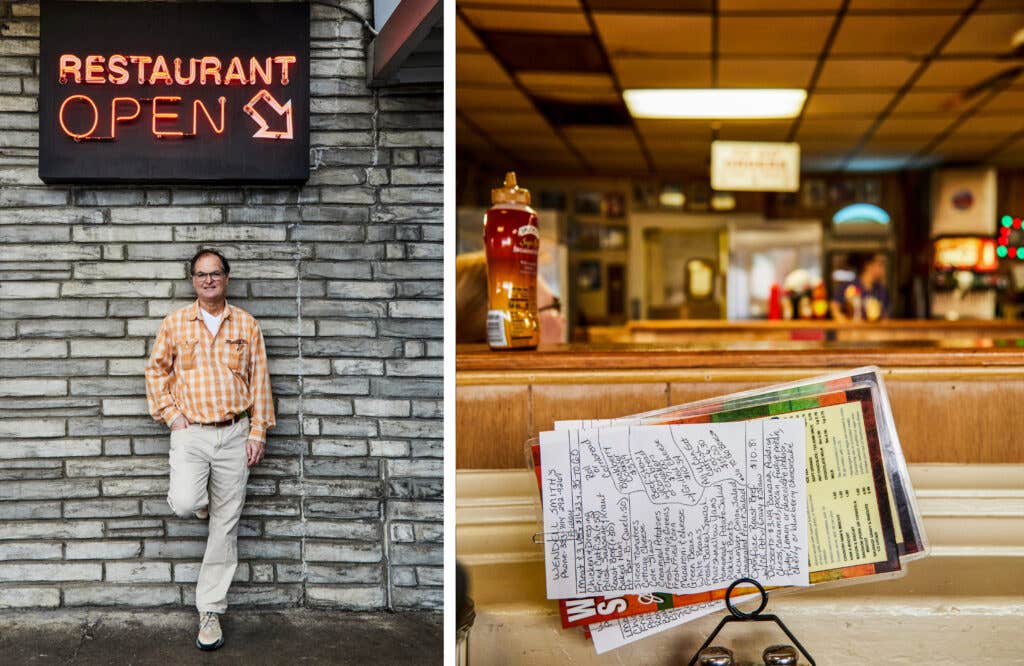
The menus at Wendell Smith’s are printed on long sheets of paper in tiny, handwritten photocopies. Options include a veritable catalog of Southern soul food: buttery lima beans, meatloaf, collard greens, fried okra, country ham, and the list goes on. “The food that rolls out this kitchen—my grandfather would probably roll over in his grave if we knew what food comes out of that little window every year,” says Cook of the restaurant’s extensive list of offerings.
The menu isn’t the only thing that’s changed. Cook has stood watch over this street corner for decades, and he’s seen the neighborhood transform firsthand. New businesses have moved in. Skyscrapers—or “skinnies,” as Cook calls them—have gone up. “This neighborhood has gentrified majorly,” he says, recalling that the neighborhood was once mostly working-class. “Now all the old people have moved on. And now, I'm the old guy.”
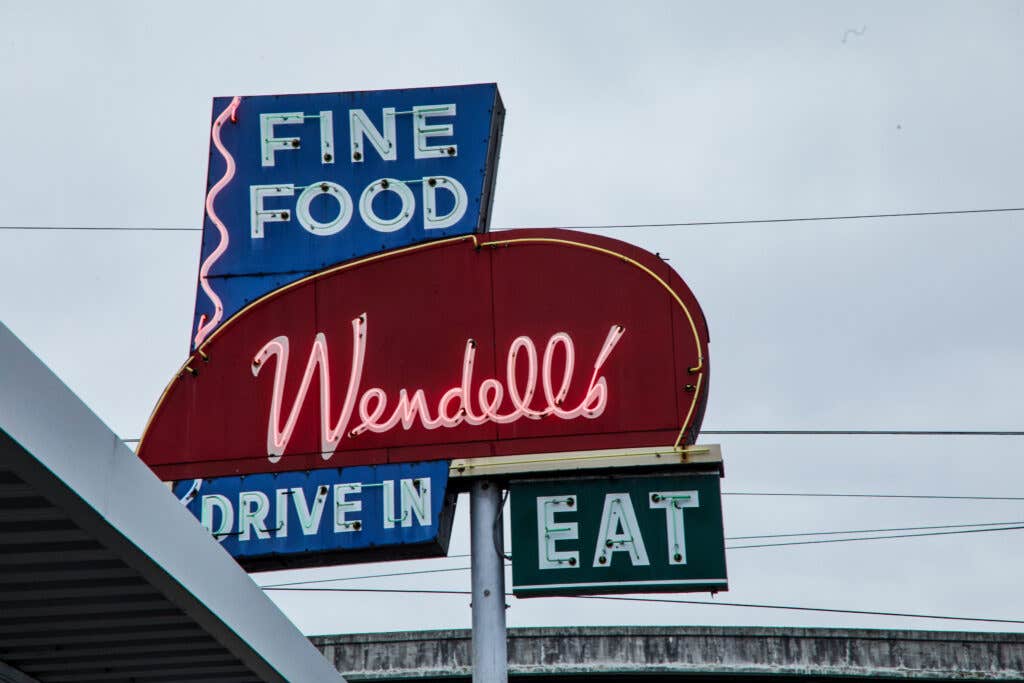
By all measures, Nashville is a much different place than it was 20, or even ten years ago. According to the 2020 census, the Nashville metropolitan area saw its population skyrocket by 21 percent compared to 2010, and is now home to almost 2 million people.
New industries have also taken root here. Amazon expanded Nashville’s tech sector when it opened a flashy new corporate office in the city in 2021; the conglomerate has plans to continue growing its local presence. Software giant Oracle is following suit, building a major hub on the banks of the Cumberland River.
Nashville’s growth is far from over. Experts predict that over the next five years, more than 200,000 more people will stream into this “small big town”. All this change means the city is now facing the classic struggles of any boomtown: overtaxed infrastructure, skeletal public transportation, lack of affordable housing, and rising cost of living.
The city’s growing pains are a stark contrast to its burgeoning tourism industry. Along Broadway, Nashville’s major entertainment corridor where both historic and upstart honky-tonks play country music well into the night, various forms of open-air jitneys prowl the streets—a kind of booze-driven, mostly unregulated streetcar. This “Transportainment”, as they’ve been dubbed, helps ferry bachelorette parties and other assorted revelers up and down the main drag, drawn to the city by its enigmatic nickname that promises a certain kind of fun: “Nash Vegas”.
Amidst all these growing tourist attractions, however, are the city’s bulwarks: the watering holes, the meat-and-threes diners, the late-night joints that have been around since what seems like time immemorial to its longtime residents. But there have been reminders that even long-established institutions aren’t immune from the changes sweeping the city, with the Covid-19 pandemic exacerbating the transformation.
The Hermitage Cafe, a storied Nashville diner, closed late last year after decades of serving late-night grub south of Broadway. Rotier’s, another venerable storefront that had dished out classic cheeseburgers, pies, fried grub and other comfort food since 1945, also shuttered last year after the landlord declined to renew the lease.
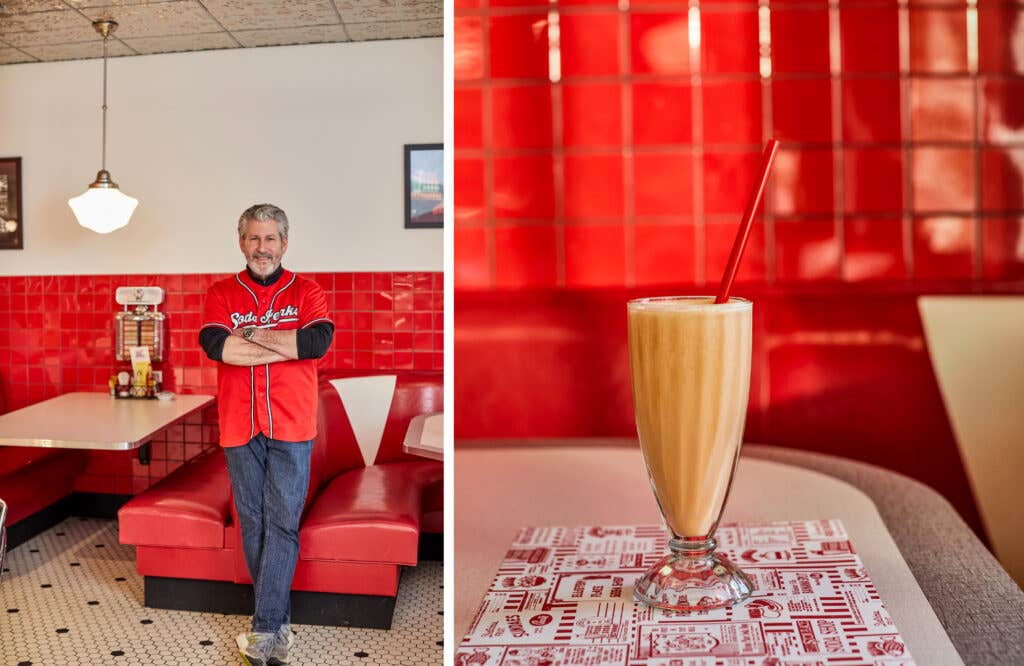
A few blocks away from the bright lights and sounds of the Broadway honky-tonks and party wagons, Elliston Place Soda Shop is trying to buck this trend. Located in a prime spot north of Vanderbilt University and close to Centennial Park, Elliston Place Soda Shop has been open since 1939, barring a renovation in 2019 that moved the restaurant next door into a larger, airier space. The new location is decorated in a classic '50s style, marrying art deco with modern exposed wood and bright red accents. The design evokes the interior of a postwar Chevy, or a vision board for the set of American Graffiti.
Despite the renovation, the menu of the Soda Shop remains firmly tied to its roots as a traditional meat-and-threes spot. “We want to be cognizant of the fact that we've got a lot of people who've been eating here for years,” says Jim Myers, marketing manager at the Soda Shop and former food critic and columnist for The Tennessean. “We continue to be affordable for the construction guys coming up off the street. Because that's what meat-and-threes are.”
Like any old-school diner worth its salt, the Soda Shop has an off-menu item: the Elmer, a tart, orange sherbet-buttermilk drink that is institutional knowledge among old-timers. “We get asked for it about once or twice a week from older clientele,” Myers says. And the drink's name? It derives from old Borden Dairy Company ads from the 1950s which starred the brand’s mascot, Elsie the Cow. “Elmer the bull, who was Elsie’s husband, was fond of buttermilk in those old ads. Borden Dairy used to promote drinking buttermilk with orange sherbet as a refreshing drink in the summer,” Myers explains.
Elmer wound up switching career paths to become a glue mascot later in life, but in Nashville, his original legacy as a dairy king lives on. Decades after its opening, Elliston Place Soda Shop still serves up the Elmer to anyone who asks for it, a reminder that some things don’t change. But after nearly a century in pretty much the same location on Elliston Place, the Elmer recipe sometimes feels like the only constant for the Soda Shop. The neighborhood, sometimes known as the “Rock Block” for its concentration of rock clubs and Nashville counterculture, has seen tremendous growth along with the rest of the city, with the prime location spurring new housing developments and businesses. “All cities go through developmental phases,” Myers says. “And it feels like, to most Nashvillians, that a switch was flipped and it's wholesale change everywhere.”
That change is keenly felt in the city’s hospitality industry. “It went from this very collaborative community of chefs and restaurateurs,” Myers explains, “to chefs and restaurant groups from out of town literally trying to poach people from your restaurant while they're eating there,” he says. “That’s not the Nashville Way.”
The Nashville Way, as Myers explains it, is a state of mind. “It's like we're neighbors,” he explains, noting the supportive attitudes business owners embody toward each other: “‘We love what you guys are doing down there. If there's anything you ever need, let us know. If you run out of anything, we can help.’”
“I think what we're grappling with is, a lot of the new people don't understand that,'' Myers concludes. “What it is and what that means. And not necessarily through any fault of their own.”
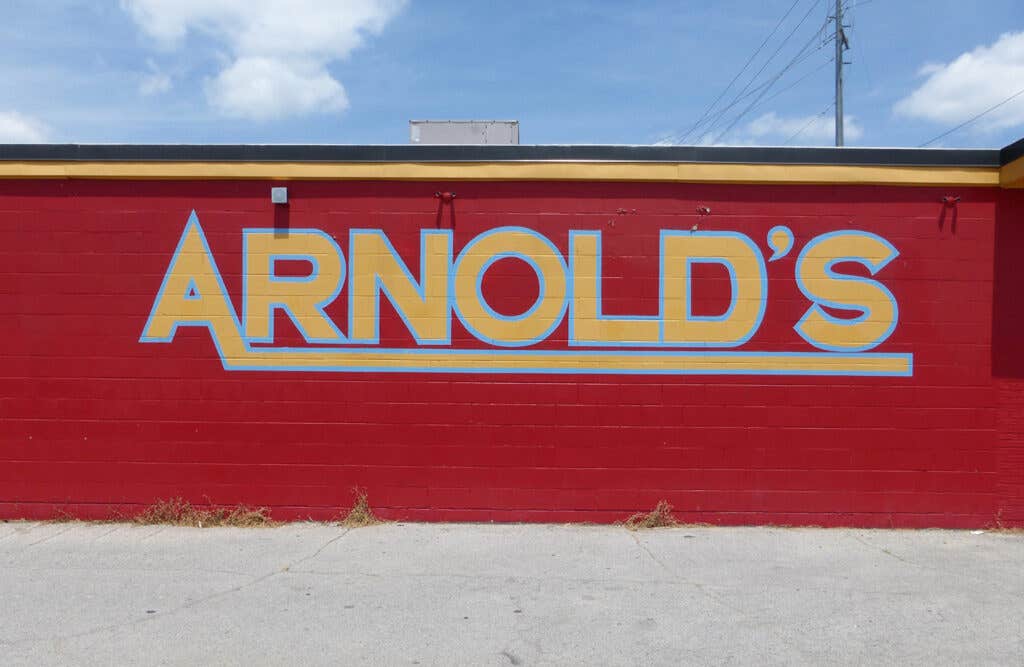
“Are they parking here? Really?” It’s late lunchtime at Arnold’s Country Kitchen, one of Nashville’s most famous spots for meat-and-threes since 1983, and its owner Kahlil Arnold is looking out the window, anxious to catch non-customers parking on his property. “Hey, could somebody check in the parking lot?” he calls out.
“If you’re eating at Arnold’s, parking’s free,” he explains, keeping one eye on the window. “So we try to keep that for our customers.” His regular customers are the backbone of his business. “They’ve taken care of us because we’ve been a local institution,” Arnold says. “We’re very fortunate that that’s how Nashvillians take care of Nashvillians.”
Arnold has some advice for the new generation of restaurants opening in Nashville alongside the population boom: “A lot of [new restaurants] come in here and just kind of throw dirt on other ones…yeah, we don’t do that here,” he says. “We'll welcome you and accept you as part of our own.”
Back at Wendell Smith’s, Cook brings up the same point. “We treat everybody the same, man, whether you don't have a nickel in your pocket or if you're a billionaire. It's just the way we are.” That feeling extends to the restaurant next door, even when its customers take up his lot, Cook admits. “They encroach on my parking lot and wear me out about that,” he says. “But I'd loan them a case of eggs if they needed it.”
The conversation turns to the Hattie B’s location across the street, a newer homegrown chain. “They fell into it and killed it,” Cook says. “We used to see lines out the door at 10:30 when they get ready to open.”
A few decades ago, a shiny new chain restaurant across the street from Wendell Smith’s would have felt out of place. But now, Hattie B’s, which opened its first location in 2012 and is currently expanding outside Tennessee, is just one of the latest businesses to enter a segment of Nashville’s food scene that has rocketed in popularity over the past decade: the fried hot chicken sandwich.
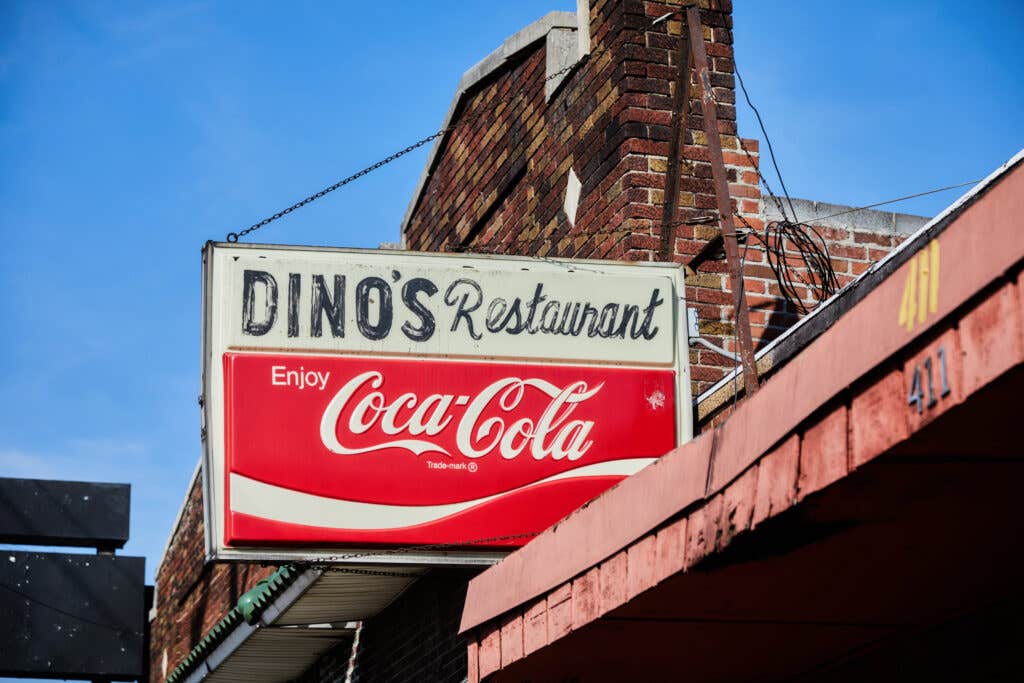
No dish embodies the Nashville Way, or how Nashville has changed, more than the hot chicken sandwich. One of the city’s prime cultural exports along with country music and the Grand Ole Opry is this fiery, cayenne-forward fried chicken. Traditionally served with pickles and white bread, it was historically an African-American dish, according to Rachel Martin’s 2015 piece in The Bitter Southerner, almost exclusively served in Black-centered neighborhoods.
This was before, according to Martin, it became the center of a targeted campaign to make the dish one of Nashville’s culinary emblems. Former Nashville mayor Bill Purcell loved hot chicken so much that he spearheaded an effort to make it part of the city’s cultural identity, and set up the first citywide hot chicken festival to spread awareness of the mouth-numbing recipe.
To say his efforts succeeded would be an understatement. Now, KFC’s nationwide menu includes a hot chicken sandwich that sells like hotcakes, and Americans from coast to coast seek out “Nashville hot” when ordering wings and chicken sandwiches.
Though Prince’s Hot Chicken Shack is largely accepted as the creator of the original recipe for hot chicken, the post-Purcell boom gave rise to many businesses trying to ride that hot chicken wave.
Across the Cumberland River from downtown and Broadway, a ways into East Nashville, Dino’s Bar—a historic dive with an old-fashioned backlit Coca-Cola sign lighting up the unassuming entry—also introduced its own hot chicken recipe, propelled not only by demand from the dish’s rising prominence, but also by the changing neighborhood. “No one ever came across the river from the west side of town,” says Dino’s owner Alex Wendkos of the neighborhood a decade ago, when there were only a couple of bars around.
Dino’s has served up drinks and one of the nation’s best cheeseburgers since the 1970s (and Anthony Bourdain stopped by for a Parts Unknown episode, too), but the decision to add a hot chicken sandwich was driven, in part, by the changing neighborhood, Alex concedes.
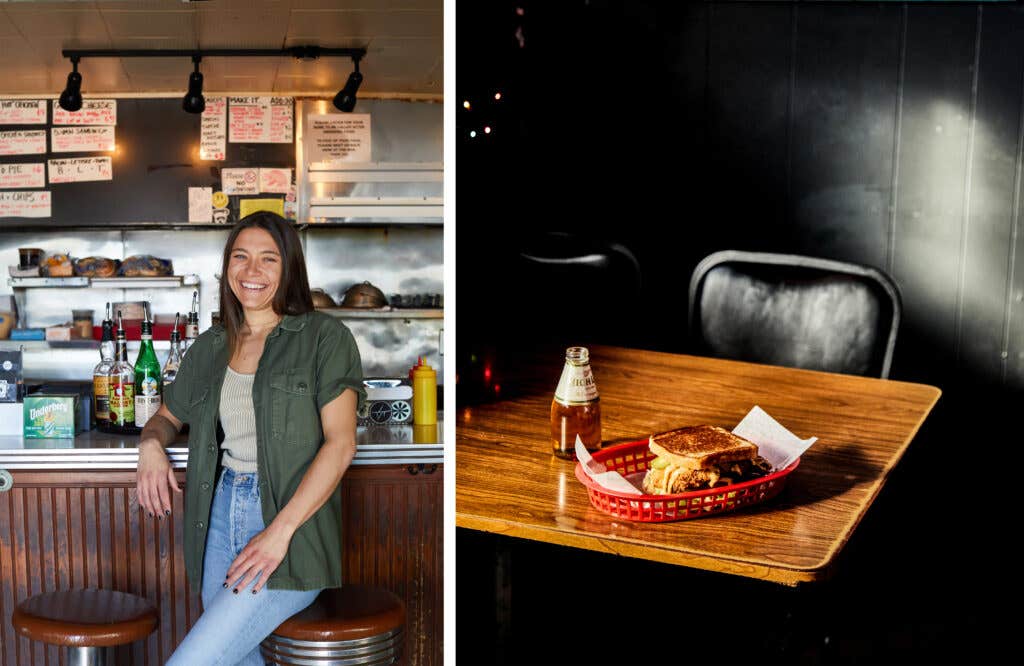
“Everyone was putting hot chicken on their menu, and it seemed like it was attracting the tourists who would go around looking for it,” she says. “It was like, ‘Let's just embrace what we do best in this town,’ or one of the things that we do well.” And the hot chicken sandwich at Dino’s is, indeed, done well: the chicken is crunchy, the coating is spicy, and the addition of cool tartar sauce, though non-traditional, is a welcome respite from the mouth-numbing power of cayenne.
Despite the competition, Nashville’s hot chicken purveyors say that the business isn’t as cutthroat as outsiders might expect. “I think it's a respect thing, to the old classic—Prince’s,” Wendkos says. “Prince’s is the god of hot chicken.”
“No one's trying to step on anyone's toes,” she adds. “We all do our own thing. You can't go wrong with Nashville hot chicken.”
At Assembly Food Hall on Broadway, a buzzy new spot with exposed industrial rafters, indoor neon signs, and a Shake Shack, an outpost of Prince’s Hot Chicken resides in the same building as a Hattie B’s. One might think this would be a Montague-Capulet situation waiting to unfold, but no such animosity exists, according to Tamara Kelly, the general manager at the Prince’s location. “They’re Hattie B’s, we’re Prince’s,” she says. “[We have] mutual respect and love for each other.”
After all, there’s plenty of business to go around—the food hall is steps removed from the bustle of Broadway’s hungry tourists, anxious to finally try that Nashville hot chicken for themselves. “Hattie’s and my guys, they laugh downstairs when they’re getting inventory,” Tamara says. “They all know each other, show pictures of grandbabies…”
Over at Party Fowl, yet another newer hot chicken chain following in the footsteps of Prince’s, albeit with a full-service concept, the story is similar. “Our people are just wonderful,” says Party Fowl co-owner Austin Smith of his home city. “We all look out for each other.”
“Everybody kind of does their own kind of different variation [of hot chicken],” Arnold says. “But everybody around here is like, if you're combating anything, it's not each other, it's the city.”
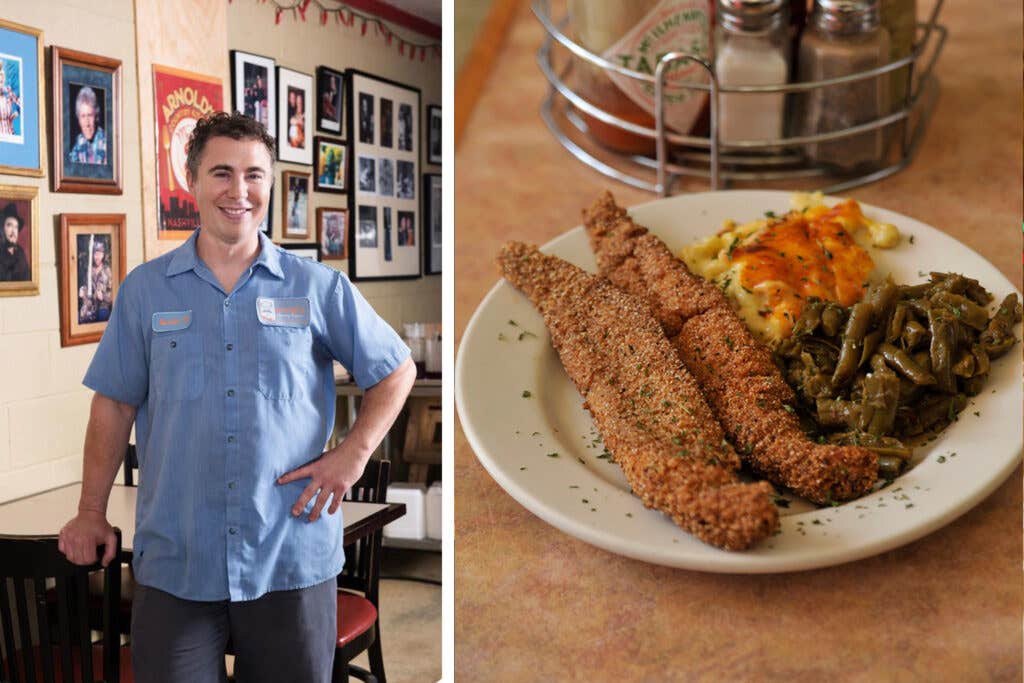
Back at Arnold’s Country Kitchen, a family walks through the door. “You coming in to grab some food?” Arnold calls out. It seems like the family’s first time—they mill about the entrance, seemingly confused by the cafetera setup (the line is hidden behind the bar and can be hard to find). “All right, you go right down this hallway, back here and they'll take good care of you,” he says, pointing around the corner. “And then if you want a drink, come around here and I'll pour you the strongest drink you've ever had.”
At its core, the Nashville Way, as Arnold and many others put it, is about kindness. It’s a small-town attitude that everyone is in it together, that a rising tide lifts all boats. And according to some, it’s an attitude in danger of fading away as Nashville’s population grows and changes. “[The city] felt very tight and everyone knew everyone, and you would drop anything to go and help,” Wendkos says. “And now it’s like you’re losing touch with one another because it’s growing so rapidly.”
Jim Myers puts it more bluntly: “One of the most irksome things in this town has always been the new chef that comes to town and says, ‘I'm going to show you people what real food is,’” he says.
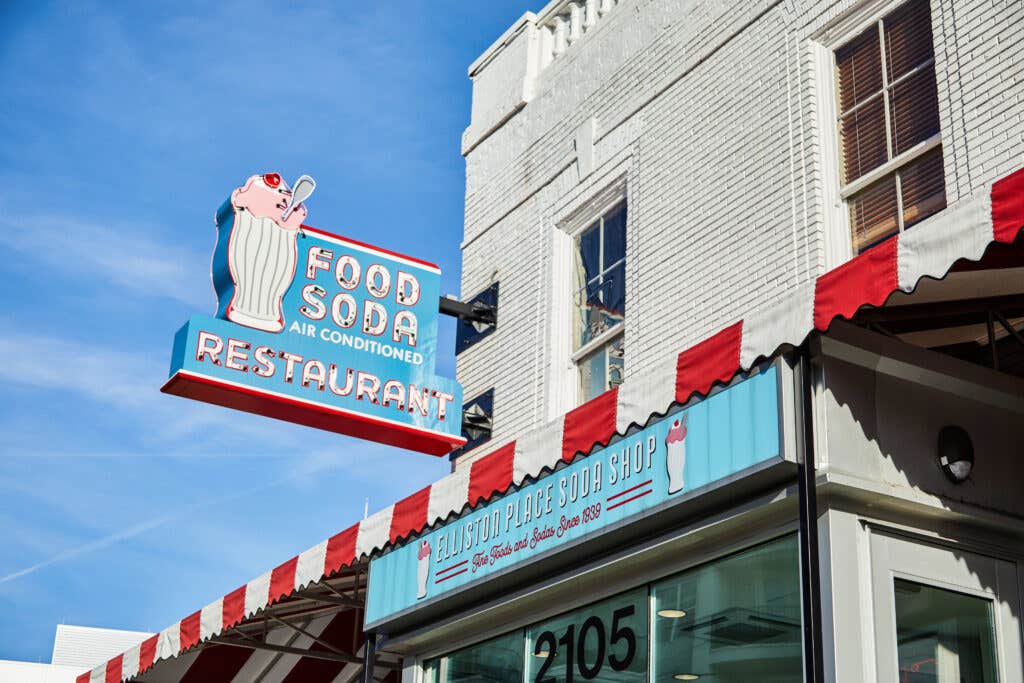
Elliston Place Soda Shop is one of the establishments trying to toe the line between past and present. “We've invited everyone in, and again, that's the Nashville Way,” he says. “Our menu is very close to the way it’s been for the last 50 years,” he explains. ”But we can’t just be a straight-up Southern meat-and-three, if we want to attract this broader demographic.” A spin on eggs Benedict that includes Southern-style red eye gravy and country ham, for example, has made it onto the menu.
“We're counting on the fact that as Nashville is changing so much, that people still want something that has credibility,” adds Myers, noting the importance of keeping the old classics alive.
Arnold, too, wants to maintain the essence of his cooking. “We're Southern food. We make it with love. We make it the way Granny made it. That was the way we were taught, so that's the way I'm going to keep making it,” he says. “I might add a few things here and there, but I'm not going to change who we are.”
“This is the place that if you were new to town, and you came in and showed some humility and were friendly, people would bend over backwards to help you,” Myers says. ”I don't think we're too far gone from that. I think we, just maybe, need some more efforts to create that sense of community.”
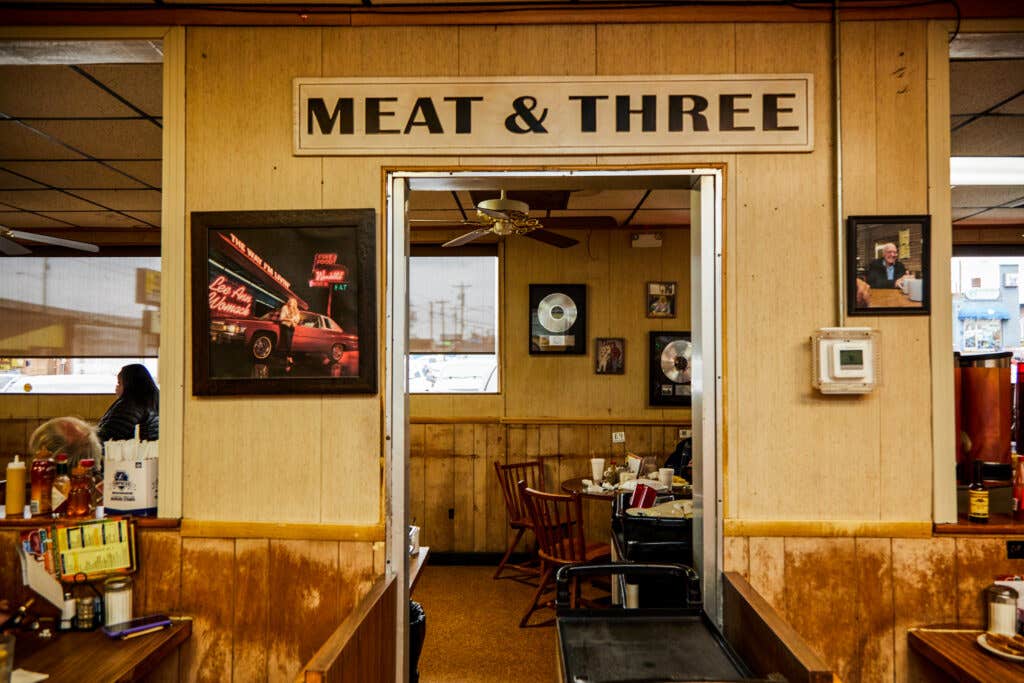
Though Nashville’s growing population has brought changes to this city, the longtime pillars of its restaurant scene hope newcomers will join them in preserving that famed community spirit. And it might already be happening.
In 2021, Hurricane Ida made landfall in Louisiana, wreaking havoc as it pushed inland. While it had been downgraded to a tropical depression by the time it reached Nashville, the storm and its preceding floods still caused significant damage to the city and its businesses. What happened next, according to Arnold, was a display of camaraderie that reminded him of the best of Nashville. “It was like everybody in Nashville dug in and helped each other out,” says Arnold. “We take pride— when something happens, no matter what your community is or what your ethnicity is or whatever you are.”
“There's no city like Nashville.”
Keep Reading
Continue to Next Story









